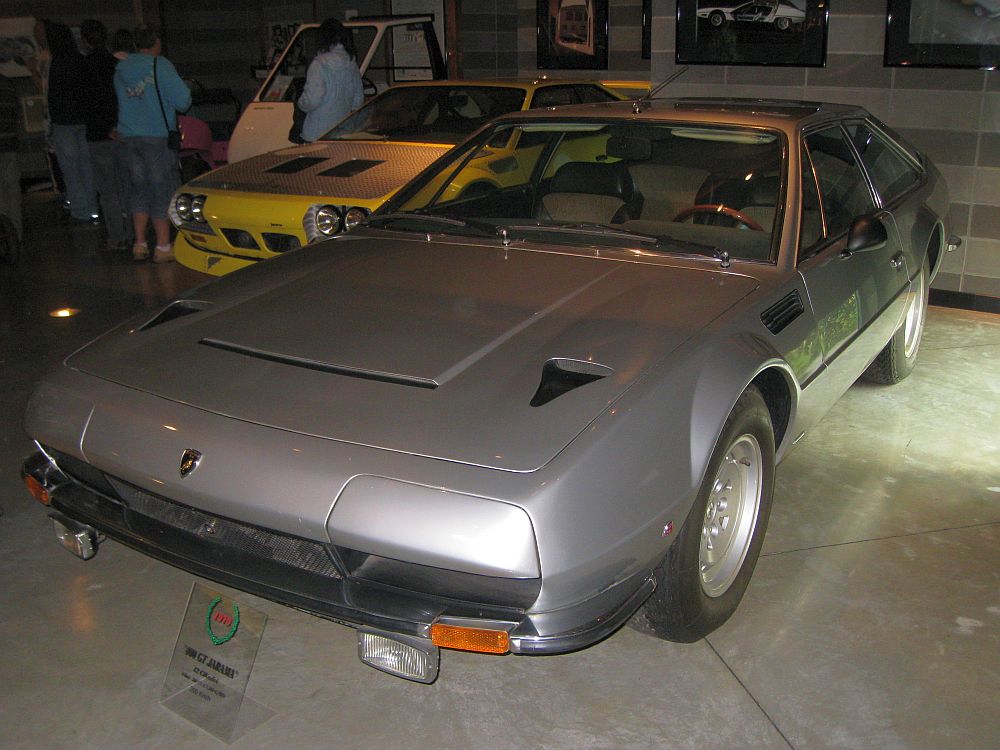Description
The Lamborghini Jarama 400 GT, introduced in 1970, was a bold and distinctive grand tourer that carried forward the legacy of Lamborghini’s front-engined V12 lineage. Positioned between the elegant Islero and the futuristic mid-engined Miura, the Jarama represented the final refinement of Ferruccio Lamborghini’s original philosophy—a fast, luxurious, and usable GT designed for effortless high-speed touring. Named after the Jarama River region of Spain, famous for its racing circuit, the car combined muscular styling with technical sophistication and became one of the most underrated Lamborghinis of its era.
By the late 1960s, new safety and emissions regulations were reshaping the European and American automotive markets. Lamborghini needed a car that would meet these standards while maintaining the power, luxury, and refinement expected of the brand. The Jarama was built to replace the Islero, using a shortened version of the Espada’s chassis but with a tighter, more compact body. It retained the classic Lamborghini formula: a front-mounted V12 engine, rear-wheel drive, and a beautifully appointed interior wrapped in sharp, purposeful design.
Under its long, sculpted bonnet lay the same 3,929 cc all-aluminium V12 engine used in the Islero and Espada. Equipped with four overhead camshafts and six twin-choke Weber carburetors, it produced 350 horsepower at 7,500 rpm and around 392 Nm of torque. Power was sent to the rear wheels through Lamborghini’s own five-speed all-synchromesh gearbox and a limited-slip differential. The Jarama’s performance was formidable: 0 to 100 km/h (62 mph) took about 6.5 seconds, and top speed was around 255 km/h (158 mph). Despite its power, the V12 was smooth, flexible, and remarkably tractable, capable of cruising quietly at low revs or delivering fierce acceleration with a press of the throttle.
The chassis was a shortened version of the Espada’s steel platform, with a wheelbase reduced to 2,380 mm for greater agility. The fully independent suspension—double wishbones with coil springs and telescopic dampers—was tuned for both comfort and control. The car featured ventilated disc brakes on all four wheels and precise rack-and-pinion steering. These mechanical refinements gave the Jarama a balance of handling stability and ride comfort that made it as capable on winding roads as it was composed at high-speed motorway cruising.
The Jarama’s styling was the work of Marcello Gandini at Bertone, who also designed the Miura and later the Countach. Unlike those dramatic, mid-engined cars, the Jarama’s design expressed restrained aggression. The body was angular and compact, with crisp edges and a powerful stance. The long bonnet, pop-up headlights, and muscular rear haunches gave it a sense of latent power, while the wide track and low roofline emphasized its sporting character. The cabin was pushed slightly rearward, creating a purposeful, cab-backward profile. Details such as the louvered rear quarter panels and the squared-off tail gave it a distinctly 1970s modernity, and the combination of practicality and style made it one of Lamborghini’s most distinctive GTs.
Inside, the Jarama was designed as a true grand tourer. The cabin was luxuriously finished in hand-stitched leather with deep, supportive seats, a thick carpeted floor, and polished metal trim. The dashboard featured a full complement of Veglia Borletti instruments within a sculpted fascia, and air conditioning, electric windows, and a high-quality sound system were standard. The interior was both comfortable and driver-focused, offering excellent visibility and ergonomics for long-distance travel. Though compact, it was a genuine 2+2, with small rear seats suitable for luggage or occasional passengers.
Driving the Jarama 400 GT revealed its dual personality: a refined touring car with the heart of a thoroughbred sports machine. The V12’s flexibility made it easy to drive smoothly in town, while its explosive power at higher revs gave it thrilling performance on open roads. The gearbox shifted cleanly, and the clutch was surprisingly light for a car of its size. The suspension provided a supple, confident ride, while the steering delivered direct feedback, allowing the driver to place the car precisely through fast corners. The balance between comfort and performance made the Jarama one of the most versatile Lamborghinis of its time—a car as enjoyable on a weekend drive as it was on a cross-continental journey.
Production of the Jarama 400 GT ran from 1970 to 1972, with just 177 examples built before the introduction of the more powerful Jarama S. Each car was hand-assembled in Sant’Agata Bolognese, reflecting the artisanal quality of Lamborghini’s early years. Although the Jarama never achieved the fame of the Miura or Countach, it appealed to a more discerning clientele—those who valued refinement and individuality over flamboyance. Ferruccio Lamborghini himself was among its owners and reportedly considered it one of his favorite models, praising its balance of performance, comfort, and usability.
Today, the Lamborghini Jarama 400 GT is celebrated as one of the marque’s hidden gems—a car that combines classic V12 performance with distinctive design and exceptional craftsmanship. Its rarity, elegance, and mechanical purity make it highly sought after by collectors who appreciate Lamborghini’s early commitment to the grand touring ideal.
The Jarama 400 GT stands as the final evolution of Lamborghini’s original front-engined GT vision. It was the car that closed the chapter begun by the 350 GT and carried forward by the 400 GT and Islero—a sophisticated grand tourer built not for racing or spectacle, but for those who understood the quiet power of refinement, precision, and timeless design.
